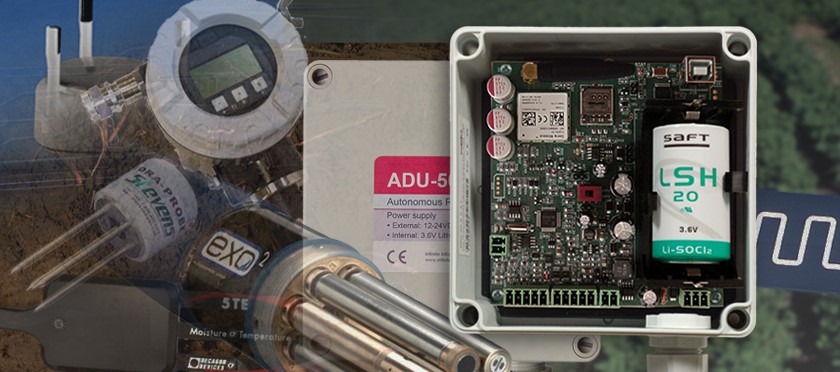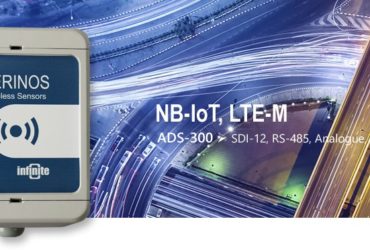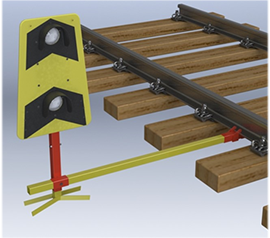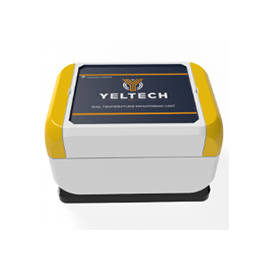
Introduction
ADU-500 is an ultra low power, wireless RTU with data logging and alarming capabilities. The battery powered RTU incorporates three digital inputs, two analog inputs, one pulse counter input, battery monitoring, and multiple excitation options for powering measuring transducers. The device supports acquisition of up to 48 measurement channels, based on the popular SDI-12 communication protocol. ADU-500 uses an internal cell modem to automatically send data and alerts. The RTU is available for GSM/EGPRS and LTE network environments. A D-size Lithium Thionyl battery can provide autonomous operation for over 10 years.
The Infinite advantage
The ADU-500 RTU incorporates the common flexible form factor (HL, CF3™) Modem modules from Sierra Wireless. ADU-500 models support NBIoT/LT-M, 4G, 3G, 2G mobile network technology. The 3G and NBIoT/LT-M version of the RTU includes GNSS capability (GPS & Glonass Sirf V).
Measurements & Data Logging
The digital inputs are scanned by the system controller for detecting an alarm condition. Analog input gain, scaling and alarm limits are user definable. The analog inputs and SDI-12 sensors are sampled according to the user defined sampling rate. Sampling rate and sampling duration affect the battery life according to the transducer power supply requirements.
SDI-12 Serial Bus
SDI-12 is an asynchronous, ASCII, serial communications protocol that was developed for intelligent sensor instruments that typically monitor environmental, structural engineering and precision agriculture data. The communication is achieved by digital communications. The addressing system allows data recorder to communicate with several microprocessor-based sensors over a single line. ADU-500 is compliant to the SDI-12 Standard Version 1.2 and supports extended commands for sensor configuration, in terminal mode. ADU-500 can collect data from several SDI-12 sensors for a total amount of 48 measurement channels.
RS-485, MODBUS
ADU-500 supports acquisition from sensors with RS-485 interface, using the popular MODBUS ASCII protocol. Up to 10 measurement channels from several sensors are supported.
Transducer excitation
The unit provides multiple excitation options for measuring transducers.
Alerting & messaging
SMS announcements include alert messages and periodical Status messages for verifying unit availability. The unit supports discrete alerting for several users. Message texts are user definable.
Data Transmission
ADU-500 supports periodical data transmission according to user defined parameters. The unit can send data via SMS to predefined users or to an internet server via FTP and data connectivity.
Setup and Remote Configuration
The unit can be programmed locally through the serial port or remotely via SMS by using simple ASCII configuration commands. The command set features commands for configuring input alarm parameters, scaling parameters and alarm limits, timing parameters and defining user groups. ADU-500 can be remotely reconfigured by sending configuration commands to the unit during the periodical status message processing.
Applications
- Weather conditions & environmental monitoring
- Water/wastewater level & quality
- Structural engineering
- Precision Agriculture
- Smart City
- Oil & Gas
- Building Management
- Factory Automation
- Power Grid
Ordering Codes
| Code | Description |
|---|---|
| ADU-500-2G | Autonomous RTU/Datalogger 2G MODEM |
| ADU-500-3G | Autonomous RTU/Datalogger 3G MODEM |
| ADU-500-4G | Autonomous RTU/Datalogger 4G LTE MODEM |
| ADU-500-NB | Autonomous RTU/Datalogger NBIoT/LTE-M MODEM |
Specifications
| Power supply | |
|---|---|
| Supply voltage | Internal: 3.6V, 13Ah Lithium Thionyl battery (Saft LSH-20 recommended) External: 9..24 VDC, 26VDC max |
| Battery Gauge | Continuous battery consumption monitoring and logging |
| Consumption | |
| Stand by | 18μA max.at 3.6V |
| Communication | SMS: average 50mA, 2A peak, FTP: average 240mA, 2A peak (GPRS/EGPRS), 650mA (WCDMA) |
| Measurement | Up to 750mA at 3.6V (according to sensor supply requirements) |
| Processing unit | |
| System controller | Ultra low power ARM 7 MCU |
| Data memory | 128 KByte EEPROM |
| Digital inputs | |
| Digital inputs | 3, dry contact, 0-30VDC |
| Pulse counters | 1, 2KHz, common with DI 3 |
| Analog inputs | |
| Input 1 (AI1) | 2, Range: 0-5V/0-2.5V, 0-1V, 0-100mV, 12 bit resolution, Gain: 1-200, digitally set (PGA) |
| Input 2 (AI2) | 2, Range: 0-2.5V, 0-1V, 0-100mV, 0-10mV, 0-20/4-20mA, 12 bit resolution, Gain: 1-200, digitally set (PGA) |
| Serial Bus features & options | |
| SDI-12 | 48 channels, up to 16 sensors, Support of extended commands in Terminal mode |
| RS-485, MODBUS | 10 channels, up to 3 sensors, MODBUS ASCII protocol |
| I2C | Low power I2C sensors (OEM versions only) |
| RS-485 | Sensors with RS-485 interface and proprietary protocol (OEM versions only) |
| Sensor excitation | |
| Output 1 | One LSH-20 Battery: 9VDC/280mA or 12VDC/210mA, Battery pack of two LSH-20 batteries: 9VDC/500mA or 12VDC/400mA (Jumper selection) |
| Output 2 | 5VDC/200mA |
| Output 3 | 3.3V/250mA |
| Communication | |
| Status & Alarm | SMS |
| Data | FTP or SMS |
| Wireless modem | Sierra Wireless 2G (HL6528RD), 3G (HL8548), 4G (HL7692 EU, HL7648 US), NBIoT/LTE-M (HL7802) |
| Antenna connector | GSM: SMA Jack |
| Serial interface | USB, up to 115 kBit/s |
| Location solution | |
| GNSS | GPS & Glonass Sirf V (HL8548-G, HL7802 only) |
| Antenna connector | SMA Jack |
| Other | |
| Temperature | -40°…65°C, operating |
| Indications | 2 LED, Network status, Operation status |
| Dimensions | 130 x 130 x 75 mm |
| Protection | IP66 |
| Weight | 0.5 kg (without battery) |
| Document | File |
|---|---|
| ADU-500, Autonomous RTU/Data Logger Datasheet v5.x | |
| Document | File |
|---|---|
| ADU-500 User Manual v5.x | |
| LSH-20, D-size, Lithium-thionyl battery | |
| WA Manager User Manual v10.x |
| Name | File |
|---|---|
| WA Manager configuration utility v10.67 |
Application Documents
| Name | File |
| Presentation Autonomous RTUs | |
| Presentation IoT for Water Telemetry | |
| Presentation IoT for Precision Agriculture | |
| Presentation IoT for Structural Engineering & Rail Systems |
Latest News
Infinite participation in the Itron Marketplace
Infinite is proud to participate in the Itron Partner Solution …
Infinite releases Aerinos ADS-300 NBIoT, LTE-M end node
Infinite is proud to announce the release of the ADS-300 …
Infinite partners with Losant
Infinite is proud to announce the partnership with Losant Enterprise …
Infinite releases new IOs and Android WaT applications v1.3.1
Infinite is proud to announce the release of a new …
Emergency Warning Board
Emergency Warning Board, based on BSC-50E
Courtesy of Yeltech, UK
https://yeltech.com/
Rail Line Temperature Monitoring
Rail line temperature monitoring, based on BSC-50D
Courtesy of Yeltech, UK
https://yeltech.com/
ADS-410 Itron Gen5 node
ADS-410 Showcased at Distributech 2019 at the Itron booth.
Courtesy of Itron , USA
https://www.itron.com/







